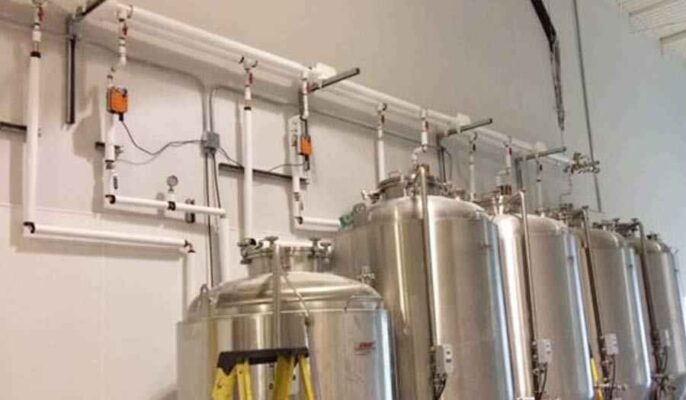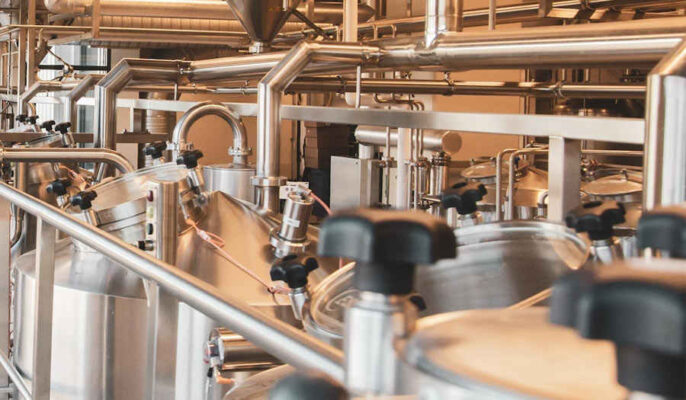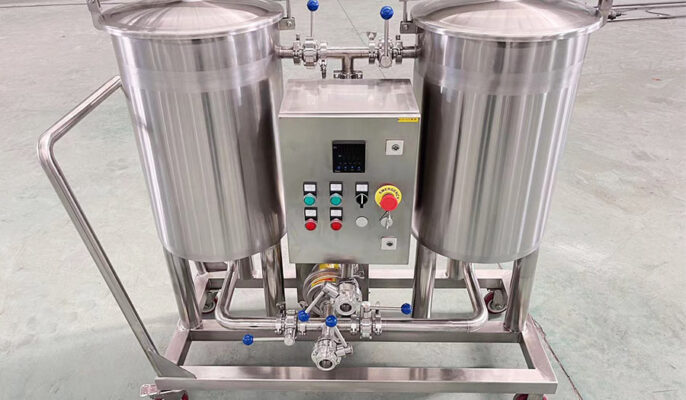India Pale Ale (IPA) is a hoppy, bitter beer style that has surged in popularity among craft brewers and consumers. Brewing quality ipa beer brewing equipmentrequires having the right equipment tailored to the style’s unique process requirements.
This guide provides a comprehensive overview of IPA brewing equipment including system components, features, supplier recommendations, cost analysis, and FAQs. It covers key considerations for equipment selection, installation, operation, and maintenance to produce exceptional IPA beer.
Introduction to IPA Beer Brewing Equipment
India Pale Ale is characterized by intense hoppy, citrus flavors and a high bitterness. To achieve this flavor profile, IPA brewing utilizes:
- Generous hop additions during the boil
- Dry hopping techniques post-fermentation
- Specialized malts for color and malt backbone
- Targeted mash temperatures and water chemistry
- Clean, highly attenuative ale yeast strains
- Temperature controlled fermentation
Specialized equipment is required to execute the IPA brewing process optimally including:

Key ipa beer brewing equipment
- Mash tun – Infuse mash to extract fermentable sugars
- Lauter tun – Filter sweet wort from spent grains
- Kettle – Boil wort and add hops
- Whirlpool – Settle hop particulates
- Fermenter – Controlled fermentation environment
- Bright beer tank – Clarify and carbonate beer
- Dry hopping vessel – Add aroma hops
- Transfer systems – Pump wort and beer gently
- Temperature control – Precise heating and cooling
- CIP system – Clean and sterilize equipment
Proper equipment enables execution of the IPA production process from mashing through fermentation and packaging.
ipa beer brewing equipment Types
IPA beer can be brewed across a range of brewhouse scales and configurations:
Brewery Scales
- Nano – 1-3 BBL production
- Micro – 3-15 BBL production
- Pub – 5-30 BBL production
- Regional – 30-100 BBL production
Larger breweries require expanded capacity while maintaining IPA optimized process flow and quality.
Brewing System Configurations
- Manual / Gravity Flow – Simple, manual process for smallest batches
- Semi-automated – Pump assisted transfers and heating
- Fully automated – Computerized batch control system
- Steam vs Electric – Heat and power utility options
- Indoor vs Outdoor – Facility configurations
Evaluate production goals, capacity, budget, and preferences when selecting a brewhouse configuration for IPA production.

Key Components of an ipa beer brewing equipment
Crafting optimized IPA requires equipment purpose-built for the style’s unique requirements:
Mashing and Lautering Equipment
- Mash tun – Mix milled grains with hot water for starch conversion. Customize temperature regimes.
- Lauter tun – Separate sweet wort from spent grains. Consider a sparge arm for efficient extraction.
- Mash filter – Combines mash and lauter tun for rapid batch sparging.
- Mill – Crushes malt into grist without excessive flouring.
- Pumps – Gentle wort transfer to avoid aeration and oxidation.
Wort Boiling and Hopping
- Kettle – Boil wort vigorously. Copper preferred for even heating.
- Burner/Steam – Powerful heat source to rapidly boil wort.
- Whirlpool – Swirl wort to settle hop particulates.
- Hop dosing – Facilitate hop additions at different stages.
- Heat exchanger – Rapidly chill hot wort post-boil.
Fermentation and Maturation
- Fermenter – Temperature controlled stainless steel or jacketed plastic.
- Dry hopping port – Access fermenter under pressure for dry hop.
- Brite tank – Clarify and naturally carbonate beer.
- Glycol chiller – Precisely regulate tank temperature.
Transfer and Cleaning
- Piping – Food-grade stainless steel or silicone tubing.
- Sight glass – Visualize wort and beer appearance.
- Transfer pumps – Low shear, sanitary centrifugal pumps.
- CIP system – Automated cleaning cycles and chemical dosing.
Proper equipment selection, sizing, and integration allows flawless IPA production from start to finish.
Key Design and Feature Considerations
Optimized IPA brewing equipment incorporates features suited for the style:
- Total automation – Automate temperatures, flows, times, etc. for reproducibility
- IoT connectivity – Monitor and control remotely via mobile apps
- Tri-clamp fittings – Tool-free sanitary connections
- Ergonomics – Efficient work flows and easy user access
- Mobile designs – Flexibility to relocate equipment
- Nano-scale options – Small batch equipment innovations
- Eco-friendly – Energy and water efficiency
- Cleaning optimization – CIP spray balls, sloped tanks, drains
- Material quality – Food-grade stainless steel throughout
Prioritize quality, consistency, ease of use, and innovation when selecting IPA brewing systems and components.
ipa beer brewing equipment Specifications
Technical specifications vary across equipment types and brewery scale:
Key IPA Brewing Equipment Specifications
| Equipment | Key Parameters |
|---|---|
| Mash Tun | Capacity, height-to-diameter ratio, insulation, false bottom, sight glass |
| Lauter Tun | Surface area and depth, sparge arm design, wort clarity |
| Kettle | Dimensions, vessel thickness, burner power, volume markings |
| Whirlpool | Rotation speed and direction, trub sink depth |
| Fermenter | Capacity, cooling power, pressure rating, cone vs cylindro-conical |
| Brite Tank | Pressure rating, carb stone type, cleaning features |
| Piping | Diameter, flow capacity, length, valves, seals |
| Pumps | Flow rate, pressure rating, impeller type |
| Control System | Sensors, automation capabilities, data logging, remote access |
Discuss specifications with equipment suppliers to match components to production goals and batch sizes.
ipa beer brewing equipment Suppliers
Reputable brewing equipment suppliers recommended for IPA systems include:
Recommended IPA Brewing Equipment Suppliers
| Supplier | Location |
|---|---|
| Specific Mechanical Systems | Canada |
| Premier Stainless Systems | USA |
| Mile Hi | USA |
| Gentle Monster | China |
| JVNW | USA |
| Ss Brewtech | USA |
| Riley Brewing Equipment | New Zealand |
Factors to consider when selecting suppliers include:
- Craft beer focus and expertise
- Quality of manufacturing and components
- Customization capabilities
- Responsive customer service and support
- Budget and lead times
- Optional turnkey installation
Evaluate options thoroughly to find the best equipment match for brewing goals and preferences.
Cost Analysis of ipa beer brewing equipment
The total capital investment for an IPA brewhouse system typically ranges:
- Nano breweries – $50,000 to $150,000
- Micro breweries – $150,000 to $800,000
- Regional breweries – $1,000,000 to $5,000,000+
Equipment costs depend on:
- Batch production capacity
- Degree of automation
- Imported vs locally sourced equipment
- Stainless steel vs plastics
- Freight and installation costs
- Media, electrical, building requirements
Get quotes from multiple vendors once specifications are defined. Weigh cost vs production quality.
Tips for Operating an IPA Brewhouse
Proper operation and maintenance ensures optimal performance:
- Execute consistent brewing schedules to “exercise” equipment
- Follow manufacturer instructions for usage and maintenance
- Perform regular calibrations on sensors and metering
- Clean and sanitize after each batch with a proper CIP regime
- Lubricate and inspect pumps and motors periodically
- Monitor equipment condition and replace worn parts proactively
- Validate cleaning efficacy via lab testing
- Schedule annual servicing and tune-ups
Trained brewers should supervise equipment usage, cleaning, and maintenance activities.

Key Trends in ipa beer brewing equipment
IPA’s continued growth drives brewhouse innovations such as:
- Integrated brewing assistant tablets
- Internet of Things (IoT) automation and data analytics
- Hybrid electric kettles combining gas and electric
- Small footprint equipment for nano breweries
- Ergonomic improvements for ease of use
- Energy efficiency and sustainability features
- Digital controls and cloud-based monitoring
- Mobile brewhouses built into shipping containers
- Precision temperature control and dosing
Expect continued equipment advancements that save energy, time, labor, and space while enhancing beer quality and consistency.
FAQs
Q: What are the most critical components for IPA equipment?
A: The mash tun, kettle, whirlpool, heat exchanger, fermenters, and centrifugal pumps.
Q: What size brewhouse is optimal for an IPA nano brewery?
A: A high quality 1-3 BBL turnkey system is recommended to start as a nano IPA specialist.
Q: Is plastic equipment suitable for IPA production?
A: All-stainless is ideal, but high quality plastic fermenters and maturing tanks can produce good results if maintained well.
Q: How much automation do I need?
A: The more automated, the better for IPA consistency. Consider at least automated temperature control and pump sequencing.
Q: Should I buy imported or locally made equipment?
A: Evaluate quality and support carefully in both cases. Imported can cost more but fits exact specs. Local is more easily serviced.
Q: What are the most critical IPA fermentation parameters?
A: Precise temperature control within 1°F and full attenuation ability of the yeast strain.
Q: How often should IPA equipment be cleaned?
A: A full CIP cleaning after every batch is essential. Disassemble and hand clean parts regularly.
Q: Should I use a whirlpool for IPA?
A: Absolutely. A whirlpool removes hop debris prior to fermentation. Use a pump-driven reverse flow whirlpool if possible.
Q: How important is a quality CIP system?
A: Extremely important. Automated, temperature controlled CIP ensures proper sanitation between batches to avoid contamination.
Q: What expertise should I look for in an equipment supplier?
A: Look for extensive prior experience designing and building IPA brewhouses specifically, not just general brewing equipment knowledge.
Conclusion
The production of high quality, consistent India Pale Ale requires equipment engineered specifically to the style’s process requirements and ingredients. Carefully selecting optimized mash tuns, kettles, fermenters, whirlpools, chilling, and cleaning systems enables craft brewers to efficiently produce distinctive IPA beers time after time. Partnering with specialists for both nano and micro scale operations is key to success. With the proper brewery in place, the possibilities for IPA experimentation and mastery are wide open.




